Across the Waterway
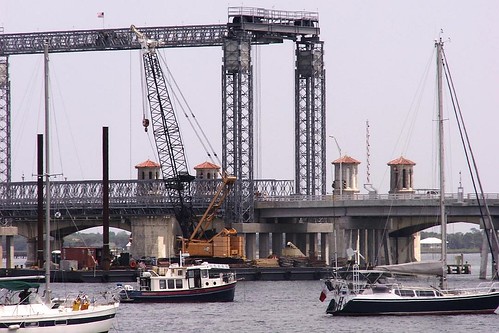
St. Augustine's Bridge of Lions, under renovation.
From the tour booklet in our hotel room: "The Bridge of Lions spans the Matanzas River. Two Carrara marble lions usually anchor the historic bridge between St. Augustine and Anastasia Island. The Lions have been temporarily removed for the bridge's rehabilitation project. Constructed in 1927, the lions were made to resemble the Loggia dei Lanzi in Florence."
From the Bridge of Lions Rehabilitation Project: "On Wednesday night, May 17, 2006, the Bridge of Lions and the temporary bridge will be completely closed from 7:00 p.m. until 7:00 a.m. Thursday morning, May 18, 2006. The closure will accommodate shifting traffic from the Bridge of Lions to the adjacent temporary bridge. In addition to the bridge closures, all lanes in both directions on Anastasia Boulevard from Gerado street to the west end of the Bridge of Lions will also be closed to accommodate the traffic shift."
We were driving down to Daytona Beach to meet with friends that evening, so we used the 312-Street Bridge instead. A City-Data.com photo of the bridge before the lions were removed is here.
A quick jaunt through the historic part of the city and a tour of the Castillo de San Marcos left us with plenty of unfinished sightseeing....
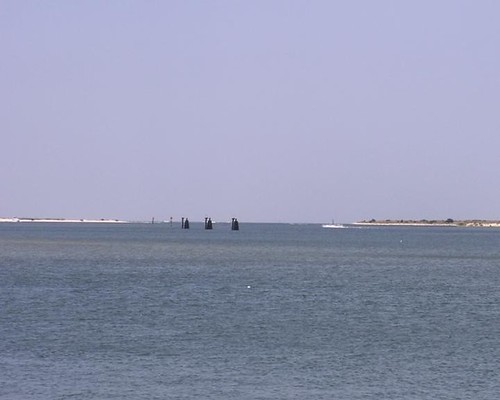
The woman staffing our hotel's front desk said, "If you want to travel south on A-1-A, don't let anyone tell you to take the Vilano Bridge. Not unless you want to swim."
This is why. Those three dark structures near the center of the shot show where the St. Augustine Inlet is located, which leads from the inter-coastal waterway out to the Atlantic Ocean.
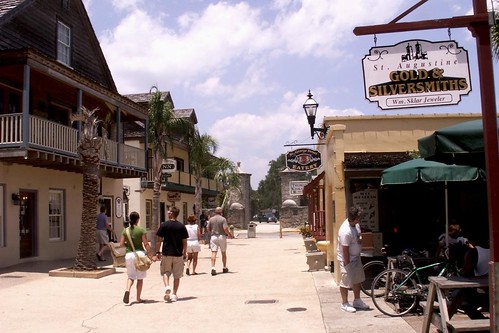
St. George Street in Historic St. Augustine, with a view toward the old city gate.
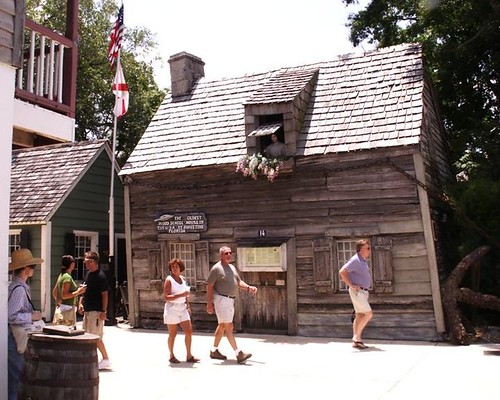
The oldest wooden schoolhouse in the U.S.
From Jackie Craven's article in About.com: "The house first appears on St. Augustine's tax rolls in 1716, but it was constructed before then. By 1788, the building was only 'in fair condition,' according to a Spanish map of that time."
She continues, "Originally, the building was a small homestead belonging to Juan Genoply. Juan Genoply later married and the house became a school, so he added an extra room. The schoolmaster lived upstairs with his family and used the first floor as a classroom. Boys and girls shared the same classroom, making the St. Augustine school the first in the young nation to go 'co-ed.'"
Mary stands in her broad-brimmed straw hat at lower left.
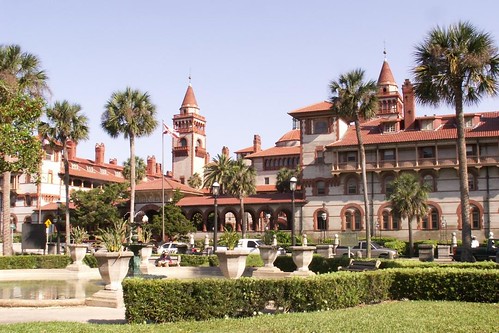
Flagler College. This site, built by Henry Flagler in 1887, was formerly the Hotel Ponce de Leon, a luxury resort for the rich and famous. The dining room, where students still eat and where functions are held, features Tiffany windows.
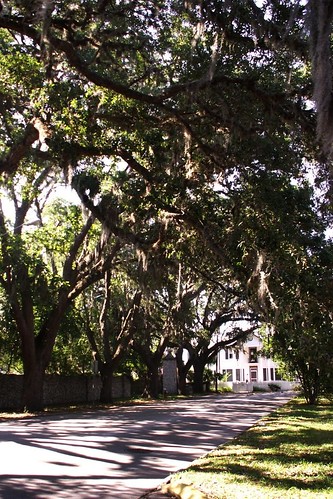
This canopy-lined street, Magnolia Avenue, is between the old jail and the Mission of Nombre de Dios.
Completed in 1891 and one of the few surviving 19th century jails, the old jail housed prisoners for over 60 years. Prisoners were originally incarcerated closer to Henry Flagler's home and businesses. In response, he had the jail house that currently stands built -- to such high standards that visitors used to think it was one of Flagler's hotels.
The mission is built on the spot where, on September 8, 1565, Pedro Menendez de Aviles landed and proclaimed the site for Spain and the Church. He knelt to kiss a wooden cross presented to him by Father Francisco Lopez de Mendoza Grajales, chaplain of the expedition. On these grounds Fr. Lopez celebrated the first parish Mass and began the work at America’s first Mission.
Many of us on this trip remarked at how similar this street looks to one in our own county, in Floral City. That road is also draped in a canopy laden with Spanish moss.
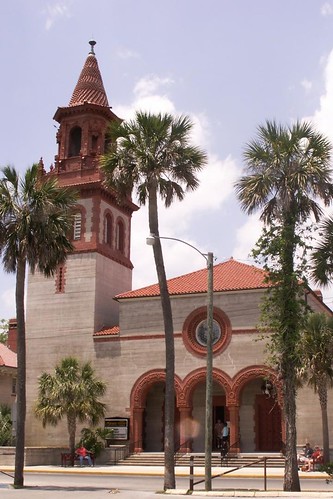
The Grace United Methodist Church, at the corner of Carrera and Cordova Streets in Historic St. Augustine. Its architectural similarity to Flagler College is not accidental.
The plaque outside the church reads, "Grace United Methodist Church is a reminder of the tremendous impact Henry M. Flagler had on St. Augustine. This complex of structures resulted from a compromise between Flagler and the congregation of Olivet Church. That group of northern Methodists agreed to exchange the land on which their church and parsonage stood for a new complex designed by John M. Carrere and Thomas Hastings. Flagler, in turn, employed the same architects in designing his Alcazar Hotel, which rose on the former Olivet site. Construction began in 1886 and was completed in late 1887. Grace Methodist Episcopal Church was dedicated in January 1888. The church and parsonage are excellent examples of the Spanish Renaissance Revival Style of architecture, and the decision to execute the design in poured concrete resulted in unusual and aesthetically pleasing structures which have stood the tests of time and the elements. Grace United Methodist Church was entered in the National Register of Historic Places on November 29, 1979."

Horseless carriage follows horse-drawn. The church is directly left of frame.
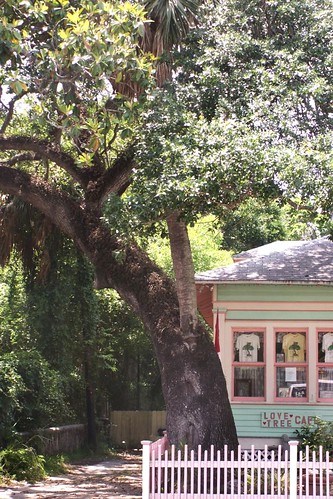
Walking down Cordova, past the horseless carriage to the street's northern end, we reached the "Love Tree." A palm tree grows out of a live oak, inseparable. Legend says that if you kiss your mate while under this tree, you will be together forever.
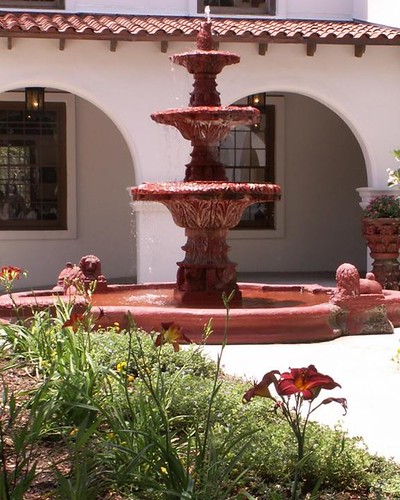
More architecture from the historic quarter.

This panhandler had stationed himself not far from the fountain on Hypolita Street. I feel a little guilty about this shot, because I didn't stop and talk with the guy. Mary and I were pretty much breezing through the historic section of St. Augustine prior to catching a presentation at the Castillo de San Marcos.
Tattooed and pierced, he had set up on Hypolita with his bedroll. He also held up a sign, but I couldn't see what it said. He spoke briefly with a couple of other folks (not those shown here) who seemed to know him. For all the historic splendor of St. Augustine, this man represents another reality.
I don't know if he is homeless, if he lives in the "slum" (as one woman who staffed our hotel's front desk called it), if he is just "slumming" (a student, perhaps). I know nothing about him -- except that he, too, is a part of the city.

Coming up: The Castillo de San Marcos.











1 Comments:
Love that love tree!
And the Vilano Bridge a hoot, or awash... :)
Post a Comment
<< Home